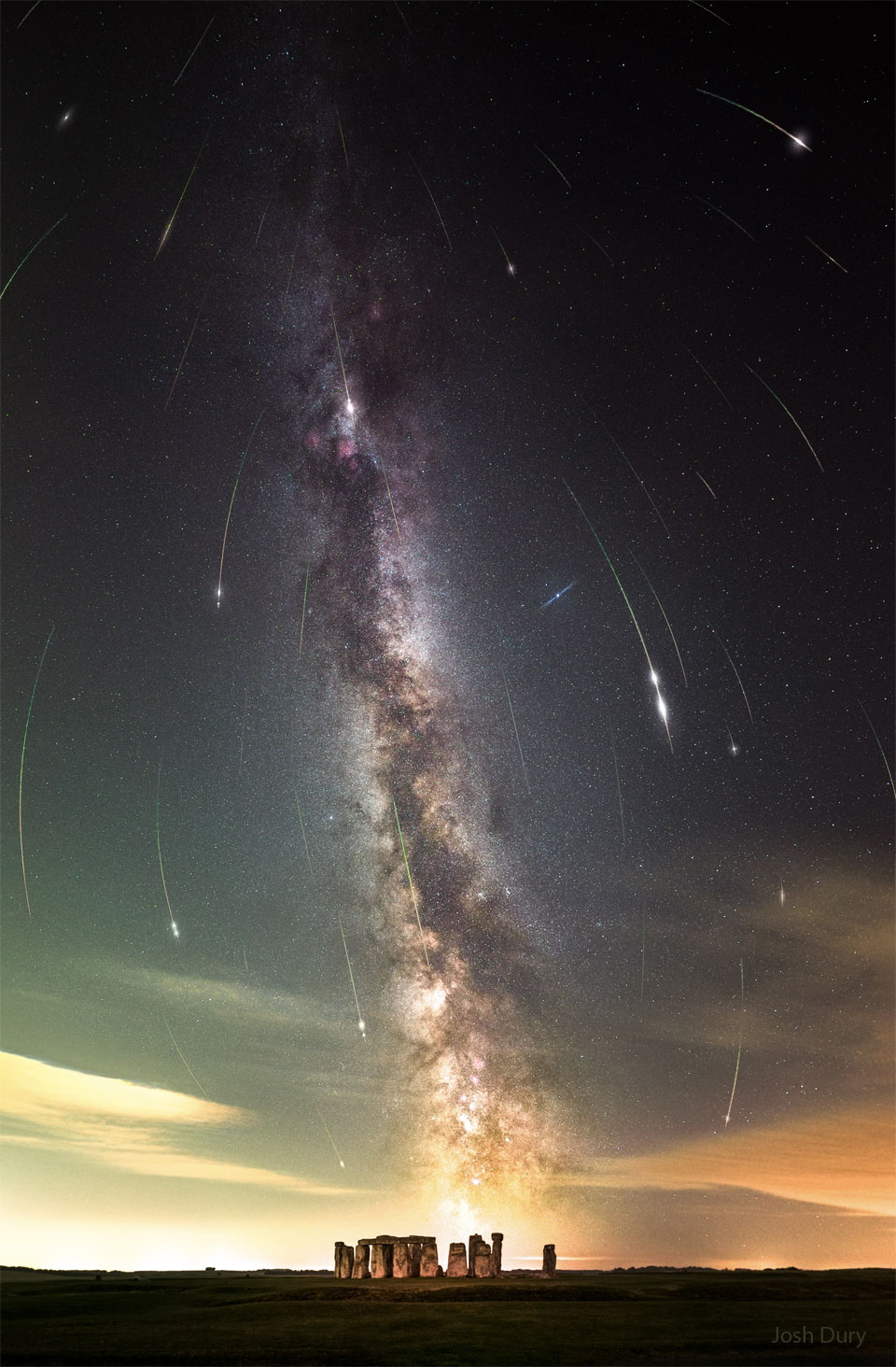12. August 2024
圓石陣 天頂 ê 英仙座流星雨

探索宇宙1!逐工會揀一幅無仝款 ê 影像抑是相片,𤆬你熟似咱這个迷人 ê 宇宙,閣有專業天文學者2為你3解說4。
- 原始文章:Perseid Meteors over Stonehenge
- 影像來源 kah 版權:Josh Dury
- 台文翻譯:An-Li Tsai (NSYSU)
[漢羅] 圓石陣 天頂 ê 英仙座流星雨
這个圓石陣 ê 天頂是發生啥物代誌? 是流星雨啦!講較詳細咧,這是 英仙座流星雨。 這張相片是 kā 幾若暗 翕--ê 英仙座流星雨 疊出來 ê 合成影像。 流星 其實是行直--ê,毋過闊幅鏡頭翕出來 ê 路線 會變做彎--ê。 這寡 流星 ê 痕跡 看起來敢若是 ùi 天頂一點 輻射出來--ê,咱 kā 叫做 輻射點。 這个輻射點是 tī 英仙座 內底。 背景夜空是用仝一台 kha-mé-lah 翕--ê,有翕著 銀河系 ê 中央帶,直直 chhāi tī 影像中央。 這張相片 是 tī 英國 Wiltshire 翕--ê,下底是足有名 ê 天文紀念碑 圓石陣。 英仙座流星雨 上強 ê 時陣是 chăng 暝,毋過 咱猶是會當 tī 紲落來幾若暝 看著 英仙座 ê 流星。
[POJ] Îⁿ-chio̍h-tīn thiⁿ-téng ê Eng-sian-chō liû-chhiⁿ-hō͘
Chit-ê Îⁿ-chio̍h-tīn ê thiⁿ-téng sī hoat-seng siáⁿ-mih tāi-chì? Sī liû-chhiⁿ-hō͘--lah! Kóng khah siông-sè leh, che-sī Eng-sian-chō liû-chhiⁿ-hō͘. Chit-tiuⁿ siòng-phìⁿ sī kā kúi-nā àm hip--ê Eng-sian-chō liû-chhiⁿ-hō͘ tha̍h chhut-lâi ê ha̍p-sêng iáⁿ-siōng. Liû-chhiⁿ kî-si̍t sī kiâⁿ ti̍t--ê, m̄-koh khoah-pak kiàⁿ-thâu hip chhut-lâi ê lō͘-sòaⁿ ē piàn-chò oan--ê. Chit kóa liû-chhiⁿ ê hûn-jiah khòaⁿ--khí-lâi káⁿ-ná sī ùi thiⁿ-téng chi̍t-tiám hok-siā chhut-lâi--ê, lán kā kiò-chò hok-siā-tiám. Chit-ê hok-siā-tiám sī tī Eng-sian-chō lāi-té. Pōe-kéng iā-khong sī iōng kāng chi̍t tâi kha-mé-lah hip--ê, ū hip-tio̍h Gîn-hô-hē ê tiong-ng-tòa, ti̍t-ti̍t chhāi tī iáⁿ-siōng tiong-ng. Chit-tiuⁿ siòng-phìⁿ sī tī Eng-kok Wiltshire hip--ê, ē-té sī chok ū-miâ ê thian-bûn kì-liām-pi Îⁿ-chio̍h-tīn. Eng-sian-chō liû-chhiⁿ-hō͘ siōng kiông ê sî-chūn sī cha̋ng mê, m̄-koh lán iah-sī ē-tàng tī sòa-lo̍h-lâi kúi-nā mê khòaⁿ-tio̍h Eng-sian-chō ê liû-chhiⁿ.
[KIP] Înn-tsio̍h-tīn thinn-tíng ê Ing-sian-tsō liû-tshinn-hōo
Tsit-ê Înn-tsio̍h-tīn ê thinn-tíng sī huat-sing siánn-mih tāi-tsì? Sī liû-tshinn-hōo--lah! Kóng khah siông-sè leh, tse-sī Ing-sian-tsō liû-tshinn-hōo. Tsit-tiunn siòng-phìnn sī kā kuí-nā àm hip--ê Ing-sian-tsō liû-tshinn-hōo tha̍h tshut-lâi ê ha̍p-sîng iánn-siōng. Liû-tshinn kî-si̍t sī kiânn ti̍t--ê, m̄-koh khuah-pak kiànn-thâu hip tshut-lâi ê lōo-suànn ē piàn-tsò uan--ê. Tsit kuá liû-tshinn ê hûn-jiah khuànn--khí-lâi kánn-ná sī uì thinn-tíng tsi̍t-tiám hok-siā tshut-lâi--ê, lán kā kiò-tsò hok-siā-tiám. Tsit-ê hok-siā-tiám sī tī Ing-sian-tsō lāi-té. Puē-kíng iā-khong sī iōng kāng tsi̍t tâi kha-mé-lah hip--ê, ū hip-tio̍h Gîn-hô-hē ê tiong-ng-tuà, ti̍t-ti̍t tshāi tī iánn-siōng tiong-ng. Tsit-tiunn siòng-phìnn sī tī Ing-kok Wiltshire hip--ê, ē-té sī tsok ū-miâ ê thian-bûn kì-liām-pi Îⁿ-chio̍h-tīn. Ing-sian-tsō liû-tshinn-hōo siōng kiông ê sî-tsūn sī tsa̋ng mê, m̄-koh lán iah-sī ē-tàng tī suà-lo̍h-lâi kuí-nā mê khuànn-tio̍h Ing-sian-tsō ê liû-tshinn.
[English] Perseid Meteors over Stonehenge
What's happening in the sky above Stonehenge? A meteor shower: specifically, the Perseid meteor shower. A few nights ago, after the sky darkened, many images of meteors from this year's Perseids were captured separately and merged into a single frame. Although the meteors all traveled on straight paths, these paths appear slightly curved by the wide-angle lens of the capturing camera. The meteor streaks can all be traced back to a single point on the sky called the radiant, here just off the top of the frame in the constellation of Perseus. The same camera took a deep image of the background sky that brought up the central band of our Milky Way galaxy running nearly vertical through the image center. The featured image was taken from Wiltshire, England, being careful to include, at the bottom, the famous astronomical monument of Stonehenge. Although the Perseids peaked last night, some Perseid meteors should still be visible for a few more nights.
詞彙學習
| 漢羅 | POJ | KIP | 華語 | English |
|---|---|---|---|---|
| 英仙座流星雨 | Eng-sian-chō liû-chhiⁿ-hō͘ | Ing-sian-tsō liû-tshinn-hōo | 英仙座流星雨 | Perseid |
| 英仙座 | Eng-sian-chō | Ing-sian-tsō | 英仙座 | Perseus |
| 流星雨 | liû-chhiⁿ-hō͘ | liû-tshinn-hōo | 流星雨 | meteor shower |
| 輻射點 | hok-siā-tiám | hok-siā-tiám | 輻射點 | radiant |
| 圓石陣 | Îⁿ-chio̍h-tīn | Înn-tsio̍h-tīn | 巨岩陣 | stonehenge |
| 岩石陣 | Giâm-chio̍h-tīn | Giâm-tsio̍h-tīn | 巨岩陣 | stonehenge |
| 銀河系 | Gîn-hô-hē | Gîn-hô-hē | 銀河系 | Milky Way galaxy |
| 闊幅 | khoah-pak | khuah-pak | 廣角 | wide-angle |
| 鏡頭 | kiàⁿ-thâu | kiànn-thâu | 鏡頭 | lens |